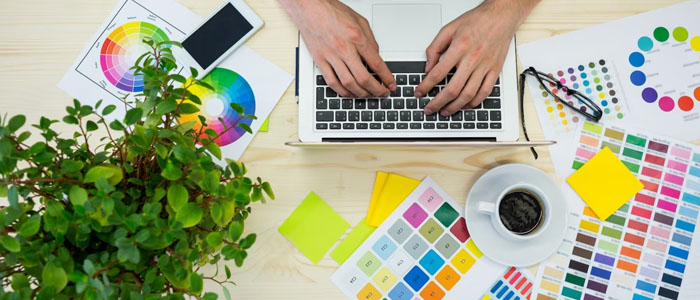A graphic designer creates visual perceptions by using different software tools or hands to deliver ideas that influence, notify, or attract consumers.
They utilize their talents to design logos, brochures, websites, packaging, and other promotional items. They work in various sectors, including publishing, marketing, and advertising. The graphic designer’s job is to produce aesthetically appealing designs that convey a certain idea or message to the target audience. With the ability to collaborate with other graphic designers and clients, they also need to be familiar with the most recent design trends and tools.
Graphic designers develop visual ideas to convey information. They design everything, including packaging, logos, marketing materials, billboards, and posters. Graphic designers use shapes, colors, typography, pictures, and other design components to communicate ideas to viewers.
An agency or a freelancer, where they deal with a range of customers, are other options for graphic designers outside working in-house, where they produce designs exclusively for one business.
In this blog post, we will discuss about the importance of a graphic designer.
Roles and Importance of a Graphic Designer?
Depending on where they work, graphic designers have different roles. For example, the designers can work on few activities that involves Selecting images and typefaces, creating layouts, and creating logos. A graphic designer could focus on motion graphics or print media.
To create designs that convey a particular message, graphic designers interact with customers and consumers. They work with other graphic designers, marketers, business analysts, authors, and programmers to build effective products, campaigns, or websites.
A graphic designer is essential in building a company’s brand and promoting its goods and services. Moreover, having a great sense of detail and excellent communication skills, graphic designers must also be able to operate under pressure and fulfill deadlines. To ensure that the finished result is visually beautiful and useful, they must also have a solid grasp of color theory, typography, and layout design.
Their work can significantly influence how individuals view the world around them as well as assist companies and organizations in properly communicating with their audiences. The visual environment of our society may be shaped and influenced by graphic designers through the creation of logos, branding, book covers, and websites, among other things. Their work can educate, motivate, and unite individuals from all cultures and groups.
Responsibilities of a Graphic Designer:
Graphic designers are responsible for various tasks depending on their profession and area of employment. To determine the requirements for the design, they frequently consult with customers or art directors.
They combine pictures, drawings, and text using design tools to make a concept come to life. They also have to present their ideas and receive feedback from colleagues or clients.
A typical job description of a graphic designer consists of some of these duties:
Developing New Designs:
Creating Visual designs that convey a certain message or idea is the responsibility of graphic designers. They may produce designs for logos, brochures, websites, packaging, commercials, or other promotional items.
Research and understand the target audience’s needs –
To ensure that the final designed product properly conveys the desired message, graphic designers must conduct research and understand the target audience before beginning to craft any design.
Collaborating with clients-
To produce designs that satisfy customers’ demands and match the entire marketing plan, graphic designers frequently collaborate closely with clients and other team members, such as copywriters or marketing experts.
Editing:
Graphic designers use designing software to create images and edit photographs and illustrations in the final product.
Looking for an Affordable
Logo Design Services
Get in touch with our 24/7 available representatives now!
Chat With us to avail 30% OFF
Selection of typography and layout design:
To produce work that is both aesthetically pleasing and useful, graphic designers need to have a solid grasp of typography, color theory, and layout design.
Presenting Ideas and Feedback to Clients –
Graphic designers frequently offer their designs to customers after they’ve been created so they may get feedback and make any required adjustments.
Managing multiple projects and meeting deadlines:
Graphic designers generally work on numerous projects simultaneously and must manage their time properly to meet deadlines.
Staying updated with the latest design trends and software – Graphic designers must keep themselves up-to-date with the newest design trends and tools to guarantee that their designs are modern and competitive.
Types of Graphic Designers
There are various categories of graphic designers, each with a particular set of abilities and specializations. The following are the types of graphic designers:
Branding Designers:
Their area of expertise is designing visual identities for businesses, organizations, and brands. They might create packaging, logos, and other visible components that support the creation of a brand’s identity.
User Experience (UX) Designers:
UX designers concentrate on creating the user experience for online and mobile products. They work to design user-friendly interfaces that encourage interaction with these products.
Web Designers:
These designers focus on producing attractive and useful websites. They could work on a website’s layout, typography, and other design components to make it user-friendly and aesthetically pleasing.
Print Designers:
Business cards, brochures, and other printed materials, as well as packaging, are designed by print designers specifically for printing. They could collaborate with printers and other vendors to make sure that the final item appears and performs as planned.
Motion Graphic Designers:
Their area of expertise is designing animations, films, and other moving images. They could work on video explanations, animated commercials, and movie and television title sequences.
Environmental Graphic Designers:
Visual designs are created by ecological graphic designers for physical environments, including grocery stores, museums, and public areas.
BENEFITS AND DRAWBACKS OF BEING A GRAPHIC DESIGNER:
Working in graphic design combines creativity and technical expertise to produce visual designs that convey ideas and messages to a particular audience. Like any profession, it may be profitable but has drawbacks. Here are few benefits and drawbacks of becoming a graphic designer:
BENEFITS:
Designers have Creative Freedom:
To develop aesthetically pleasing designs and successfully deliver a message, graphic designers have a chance to use their creative abilities and imaginative thinking.
Opportunity to have Variety of Work:
Working as a graphic designer can be fascinating and demanding since they can work on various projects and with different customers.
High Demand:
Graphic designers are in great demand across many sectors due to the growing significance of branding and marketing in today’s economy.
DRAWBACKS:
Competitive Industry:
In the very competitive profession of graphic design, it cannot be easy to distinguish oneself from other designers.
High Pressure: Graphic designers sometimes have to complete high-quality work under short deadlines, which can be demanding and cause frustration.
Irregular Income: Due to the project-based nature of graphic designers’ occupations, which may be difficult to manage, freelance graphic designers may encounter variations in their earnings.
Conclusion:
The designing field has particular responsibilities that heavily rely on the working environment and field of expertise.
This is wonderful news for individuals considering a career in the field since it allows you to choose a route that suits your tastes and goals. If you find it appealing, think about becoming a graphic designer.





